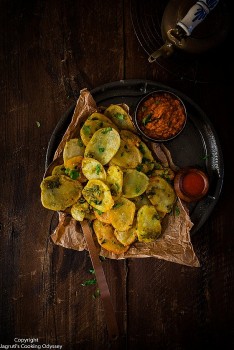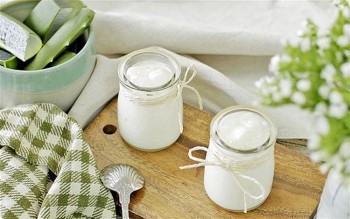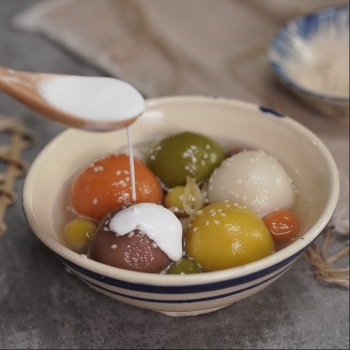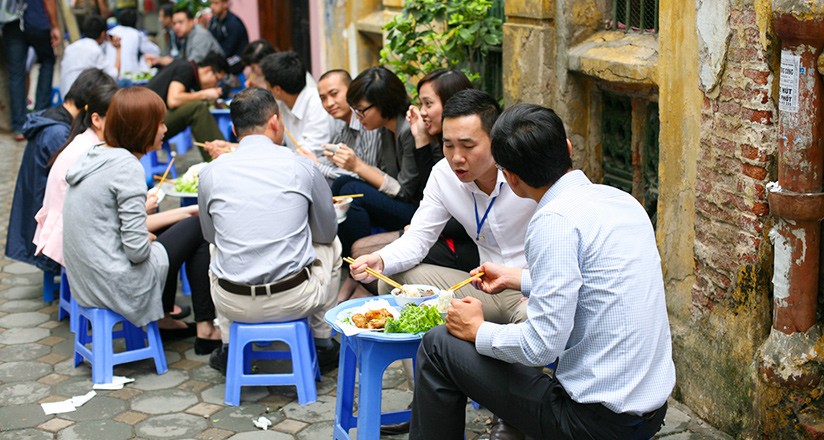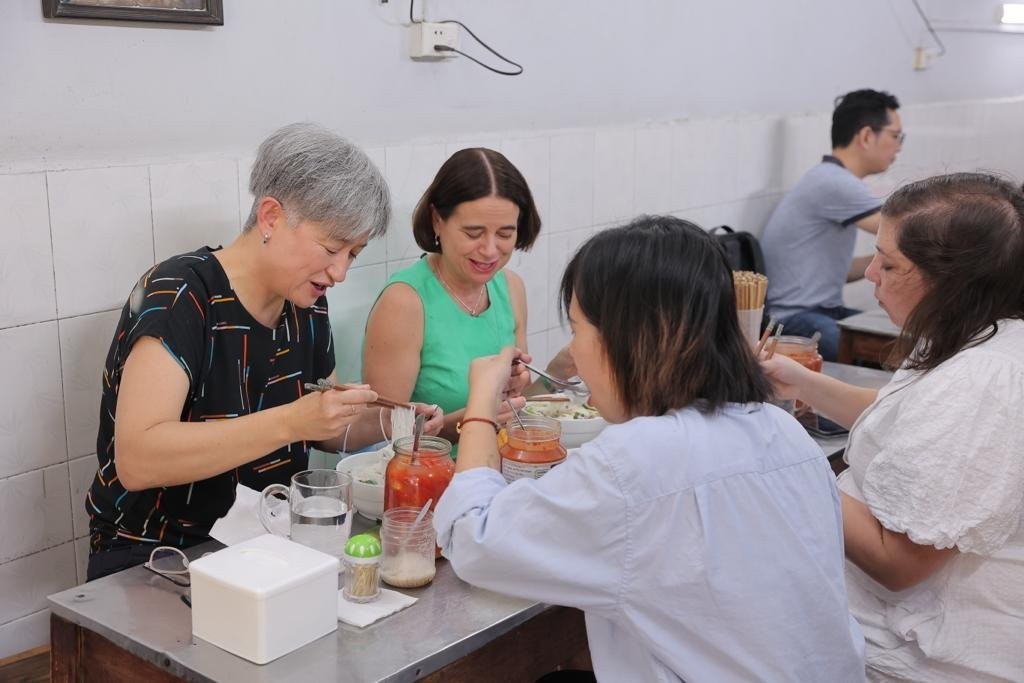How To Make Bun Cha - Iconic Dish of Hanoi
| Easy Recipe: Indian fries (Chana Na Bhajia) | |
| Lockdown Cooking: Three Easy-to-follow Dessert Recipes | |
| How To Make Colorful Floating Rice-Ball Pudding |
(Video: Savory Days Kitchen)
INGREDIENTS
A. Vietnamese Caramel Sauce
• 70 grams (5 tbsp) sugar
• 150 ml (1/2 C + 2 tbsp) hot water
B. Grilled Pork
• 450 grams (1 lb.) pork shoulder or pork belly (choose a fatty piece to prevent the meat from drying out while being grilled)
• 450 grams (1 lb.) minced pork (similarly, choose minced pork with at least 10% fat)
• 50 grams shallots (about 6 – 8 shallots)
• 15 grams garlic (3 – 5 cloves)
• Fish sauce
• Oyster sauce
C. Side Pickles
• 400 grams green papaya, carrots, kohlrabi
• 25 grams (2 tbsp) sugar
• 15 ml (1 tbsp) rice vinegar or lemon juice
• ¾ tsp salt
• Fresh herbs to serve: coriander, perilla, lettuce, Vietnamese balm, …
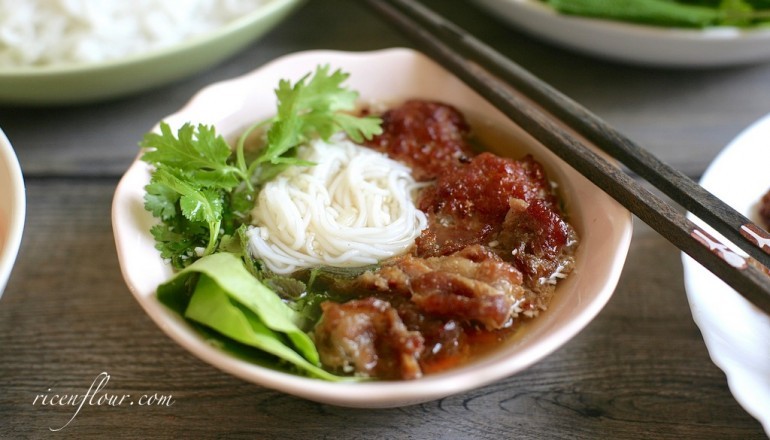 |
| Photo: Rice N Flour |
D. Dipping sauce and Noodles
Dipping sauce (nước chấm in Vietnamese) is an essential condiment in Vietnamese cuisine, and usually consists of fish sauce, sugar, lime juice/lemon juice/rice vinegar, water and minced garlic and chilli to taste. My preferred ratio for a perfect nước chấm bún chả is 1 sugar : 2/3 acid : 1 fish sauce : 7 water.
• 25 grams (1.5 tbsp) sugar
• 15 – 18 ml (1 tbsp) lemon juice/rice vinegar
• 175 ml (3/4 cup) water
• 15 – 20 ml (1 – 1.5 tbsp) fish sauce
• Garlic, chilli, black pepper – to taste
• 1.5 kg fresh rice vermicelli noodles or 0.5 kg dried rice vermicelli noodles
INSTRUCTIONS
A detailed recipe with all the specific notes is available on Savoury Days’ YouTube Channel (subscribe to get all the newly uploaded recipes) in both English and Vietnamese. Check it out at this link or the video right below. Don’t forget to turn on HD setting for best quality, according to Ricen Flour.
The steps are quite simple and straightforward in the video. In short, the whole procedure of making bun cha can be summarised in five main steps as follows:
1. marinating the meat
2. making the pickles and the dipping sauce
3. grilling the meat
4. cooking dried vermicelli noodles
5. serve
6. Therefore, instead of listing the major steps of the method as usual, in the following section, I will note down some key points that will help you make the best and most authentic bún chả.
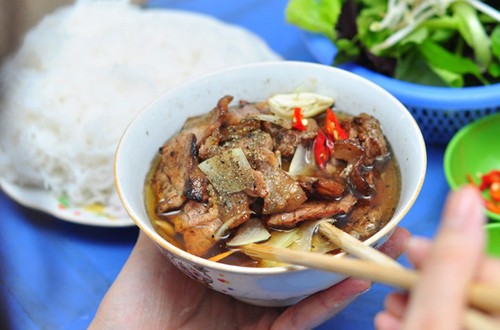 |
| Photo: Rice N Flour |
Must-know tips for the true taste of Bun Cha
A. Picking the Cut, Marinating and Grilling the Meat:
It is best to choose a fatty cut of pork, either pork belly or pork shoulder, to prevent the meat from drying while being grilled. I prefer pork shoulder because it is relatively leaner than pork belly, and the melted pork shoulder fat has a crunchy texture and savoury buttery flavour – which is rather fun to devour.
There are two types of grilled meat in a traditional bún chả: grilled pork patties (chả băm) and grilled pork slices (chả miếng). Grilled pork patties are what distinguish bún chả (from Hanoi) from bún thịt nướng (from Central and Southern Vietnam), both of which consist of rice vermicelli noodles served with grilled pork.
Another difference between the two regional dishes is that the pork marinade in bún chả does not have lemongrass, sesame seeds or sesame oil like the one in bún thịt nướng (if you would like to know how to make the grilled pork for bún thịt nướng, check out this previous recipe of mine). This is because Hanoi – situated in the North of Vietnam – has a milder tropical climate than the Central and Southern region, and therefore lemongrass – a tropical plant – is not a common ingredient in Hanoi’s culinary culture.
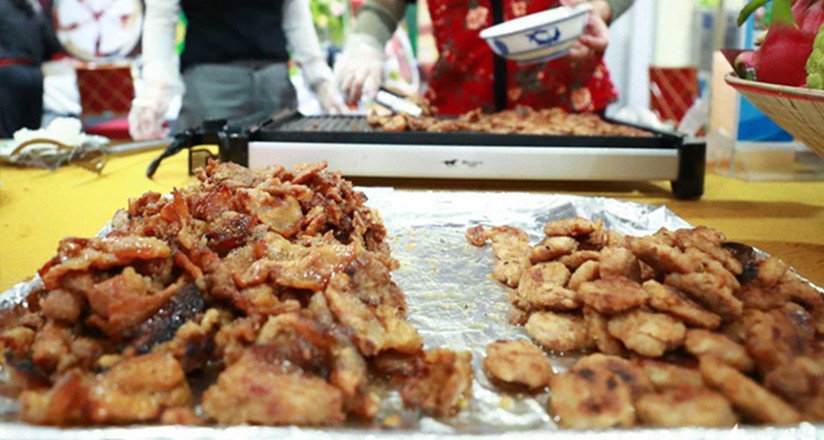 |
| Photo: Inside Vietnam Travel |
Vietnamese caramel sauce (nước màu) is NOT like the sweet caramel sauce served with desserts, but is rather used as a food colouring to give the meat in savoury dishes a golden brown colour. It is really easy to make – simply boil sugar and water together. However, you can substitute Vietnamese caramel sauce with golden syrup or honey, or even the homemade golden syrup leftover from making mooncakes!
The sugar content in all of the above will caramelise while you grill the meat, giving the pork not only a scrumptious chargrilled colour but also a smoky sweet caramel-like flavour. Just note that if you are using honey, the meat will burn more easily (since honey has a ‘purer’ sugar content than cooked caramel sauce or golden syrup), therefore, keep an eye on your grill pan.
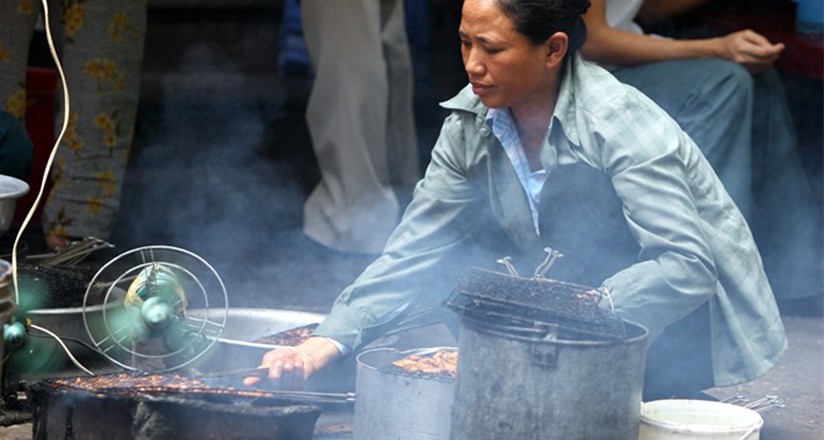 |
| The pork is best grilled over charcoal fire. Photo: Vietnam Inside Travel |
The pork is best grilled over charcoal fire – charcoal grilled pork has a far superior smoky flavour to oven grilled one. If you are using the oven, put the meat over a wired rack or a pizza pan – surfaces that allow the meat itself to be exposed to the heat from the top and the bottom. This will prevent the pork from being too dry, the grilled meat will be more tender as the heat is distributed evenly throughout, as reported by Ricen Flour
B. Pickles and Vegetables:
Vietnamese cuisine is known as one of the healthiest in the world. Almost all Vietnamese dishes have vegetables, especially meaty and fatty dishes, to balance out the flavours, textures as well as the nutrients. You will easily find pickles and an abundant amount of fresh herbs and vegetables being served with many Vietnamese traditional dishes, and they usually come free with your meal in the restaurant by the way.
Pickles in bún chả (and many other dishes such as bún thịt nướng, or bánh xèo – crispy Vietnamese pancakes) are usually made of thinly sliced green papayas and carrots. Cucumbers or kohlrabies are also great substitute for green papayas, and the contrast between the green and the bright orange colour of the pickles makes your dish more eye-catching and appealing.
Pickles are also made fresh rather than preserved for a long time. When you make the fresh pickles, it is important to add sugar first rather than salt, as it will help the pickles be more crunchy. Adding salt will immediately draw out the moisture from the vegetables and make them a bit tough to chew.
C. Boiling the Rice Vermicelli:
If you have fresh rice vermicelli – perfect. You just need to poach it through hot water just before serving, so that the rice vermicelli will soften and soak up the dipping sauce better.
If you don’t live in Vietnam or near a big Asian market, it is more likely that you will end up with dried rice vermicelli. Although some packages say that the noodles can be soaked in hot water before serving, I find that the noodles do not expand properly even after being soaked for a long time, and thus would prefer to boil them in a pot of hot water. You can also poach the noodles through hot water again just before serving.
D. Making nước chấm – dipping sauce:
The salt content of fish sauce varies from different types, so there is no fixed ratio to make nước chấm.
What I would recommend is to mix sugar, lemon juice and water together first, taste it to make sure you are happy with the lemon juice. Then, gradually add fish sauce to taste. Tasting as you go along rather than dumping all the ingredients in at once will help you identify easily which flavour component (sweet, sour, savoury, …) is lacking.
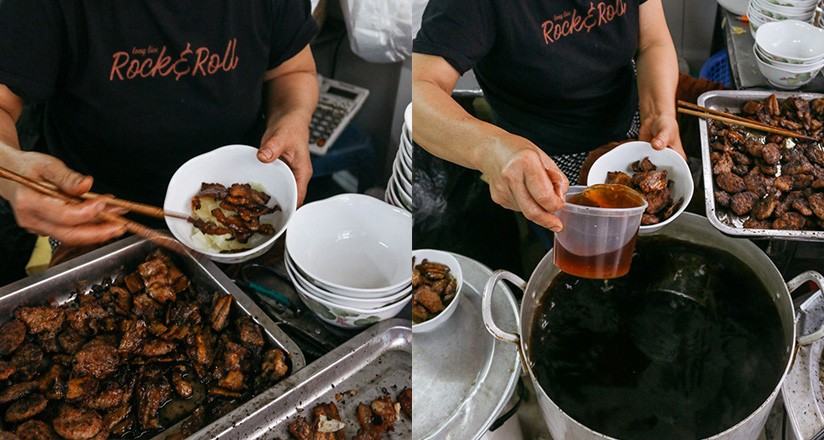 |
| Photo: Inside Vietnam Travel |
When added into nước chấm, the garlic (and chilli) should float on the surface – it looks more visually appealing rather than chunks of garlics sinking at the bottom. Here are a few tips to achieve this:
• Mince the garlic very finely, but don’t crush it. The dipping sauce should be warm when you add in the garlic.
• Soak the garlic in a little bit of vinegar and sugar before adding it into the dipping sauce.
Health Benefits of Bun Cha
According to Simple 30, the main ingredient of Bun Cha is pork. Even though is high in protein, pork also contains a fairly high amount of saturated fat. To make it healthier, try to use lean pork cuts such as pork tenderloin or sirloin pork chop to prepare the meatballs.
As for the noodles, rice noodles have a slight advantage in terms of carbohydrates when compared to egg or wheat noodles; they have a lower carbohydrate count than them. However, their carbohydrate count remains relatively high (44 grams in a cup); especially for someone under a low carb or low-calorie diet. If that is your case, try to replace the conventional rice noodle with brown rice noodles. These noodles possess a much higher fiber count.
In regard to the remaining ingredients, they are mostly used to provide flavor and seasoning. As Bun Cha is considered a highly versatile food, you can add as many vegetables as you wish to make it nutritious and colorful.
Now in terms of condiments, fish sauce is well known to be very salty; one single tablespoon can contain virtually the whole sodium intake for the day. So, if you suffer from high blood pressure issues, here are some tips for you:
1. Search for a low sodium version of the sauce.
2. Mix the sauce with water or pineapple juice to dilute the sodium content.
Instead of buying it in the supermarket, try to make it at home. This way you can have control over the salt content in the final product.
| Bun Cha is a very common dish that is thought to be originated from Hanoi. Bun Cha can be easily found in Vietnam’s busy capital city from elegant restaurants to simple street vendors in narrow streets. Along with Pho, Bun Cha also stands for Hanoi’s stunning cuisine culture which is the perfect combination of rice products, meat, veggie, spices, and local special dipping sauce.
It is available for all main meals in a day, from hurry breakfast to complete lunch then hearty dinner. However, bun cha is the top choice when it comes to lunchtime in the capital. It becomes more irresistible when the incredibly aromatic smell of grilled pork pervades streets, which tempts any hungry stomach after busy half a day. |
 | EU ambassador with love for Vietnamese cuisine The first episode of the series "90 seconds with EU Ambassadors" is now on air, featuring EU Ambassador Giorgio Aliberti and his love for Vietnamese ... |
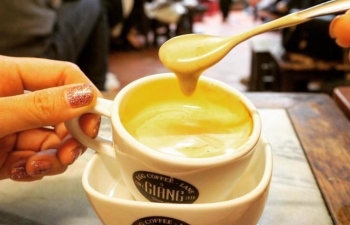 | Eight Hanoi street foods listed as must-try by French newspaper French daily Le Figaro has recently run an article suggesting eight most iconic street foods in the capital of Hanoi, titled “In Vietnam, eight wonders ... |
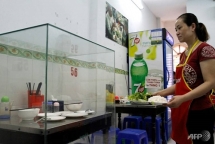 | Obama ‘bun cha ’ table encased in Hanoi The table where former US president Barack Obama famously slurped noodles in downtown Hanoi has been preserved -- chopsticks and all -- under a glass ... |
Recommended
 Handbook
Handbook
Vietnam Moves Up 8 Places In World Happiness Index
 Handbook
Handbook
Travelling Vietnam Through French Artist's Children Book
 Multimedia
Multimedia
Vietnamese Turmeric Fish among Best Asian Dishes: TasteAtlas
 Handbook
Handbook
From Lost to Found: German Tourist Thanks Vietnamese Police for Returning His Bag
 Handbook
Handbook
Prediction and Resolution for the Disasters of Humanity
 Handbook
Handbook
16 French Films To Be Shown For Free During Tet Holiday In Vietnam
 Handbook
Handbook
Unique Cultural and Religious Activities to Welcome Year of the Snake
 Handbook
Handbook

